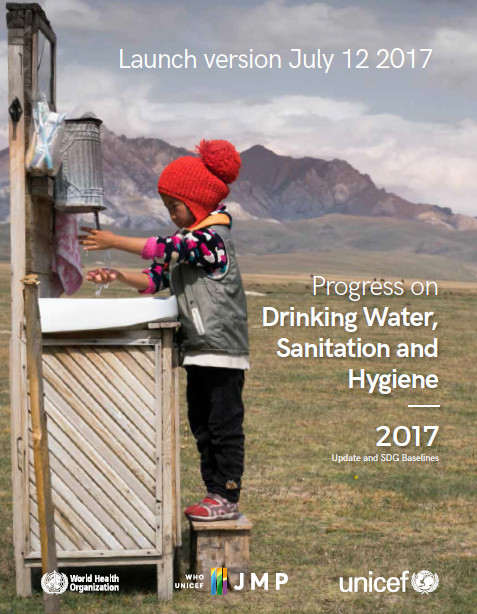Progress on drinking water, sanitation and hygiene: 2017 update and SDG baselines
 |
Progrès en matière d’eau, d’assainissement et d’hygiène : mise à jour et évaluation des ODD 2017
rapport Jul 2017 ; 114 pages
Ed. WHO - Genève
Téléchargeable sous format: PdF
Téléchargeable chez l'éditeur
Page de présentation d'un éditeur
Abstract:
The WHO/UNICEF JMP has published its first report of the SDG period, Progress on drinking water, sanitation and hygiene: 2017 update and SDG baselines. The report introduces and defines the new indicators of safely managed drinking water and sanitation services. Estimates of safely managed drinking water services, the indicator for SDG target 6.1, are presented for 96 countries, while estimates are provided for safely managed sanitation services (target 6.2) for 84 countries. SDG target 6.2 also includes hygiene, and the JMP has rebranded itself as the WHO/UNICEF Joint Monitoring Programme for Water Supply, Sanitation and Hygiene. This first SDG report presents data on the availability of handwashing facilities with soap and water in the home for 70 countries.
The newly updated JMP website, www.washdata.org, allows visitors to interactively access the full dataset, and download individual country files which include all of the data used to produce the estimates. (Login with username “washdata” and password “preview”.)
The report finds that in 2015, 29% of the global population (2.1 billion people) lacked safely managed drinking water services – meaning water at home, available, and safe. 61% of the global population (4.5 billion people) lacked safely managed sanitation services – meaning use of a toilet or latrine that leads to treatment or safe disposal of excreta. Data on handwashing were too few to make a global estimate, but in sub-Saharan Africa, 15% of the population had access to a handwashing facility with soap and water.
The 2.1 billion people without safely managed drinking water services includes 1.3 billion people with basic services, meaning an improved water source located within 30 minutes; 263 million people with limited services, or an improved water source requiring more than 30 minutes to collect water; 423 million people taking water from unprotected wells and springs, and 159 million people collecting untreated surface waterfrom lakes, ponds, rivers and streams.
The 4.5 billion people without safely managed sanitation services includes 2.1 billion people with basic services, meaning an improved sanitation facility which is not shared; 600 million people with limited services, or an improved sanitation facility which is shared; 856 million people using unprotected latrines or bucket toilets, and 892 million people collecting practising open defecation.
Safely managed services represent an ambitious new global benchmark and estimates are not yet available for all countries. The report identifies a number of critical data gaps that will need to be addressed in order to enable systematic monitoring of SDG targets, if we are to realise the SDGs commitment to “leave no one behind”.
Yet the data we have now are more than enough to show the tasks at hand: to eliminate open defecation for the nearly 900 million people who continue to lack even the most rudimentary sanitation; to bring basic water, sanitation and hygiene within the reach of the most disadvantaged; and to support progress for those who already have basic services, but still don’t have truly safe drinking water or adequate sanitation.
These SDG baseline findings set a clear agenda on the work to be done for all of us across the world to progress towards the shared vision of Water, Sanitation, Hygiene and Health for All.
JMP website: www.washdata.org (Login with username “washdata” and password “preview”)
Publics-Cibles:
Université , Acteurs de coopération , Socio-économiste , Décideurs locaux ou nationaux
Mots clefs: |
mondial (CI) (DT) (OP) (ope) , ODD Objectifs Développement Durable (CI) (DT) (OP) (ope) , post-2015 (CI) (DT) (OP) (ope) |
Editeurs/Diffuseurs: |
|
WHO
-
World Health Organization - Genève - Suisse |
UNICEF - New York - Etats Unis |
En cas de lien brisé, nous le mentionner à communication@pseau.org